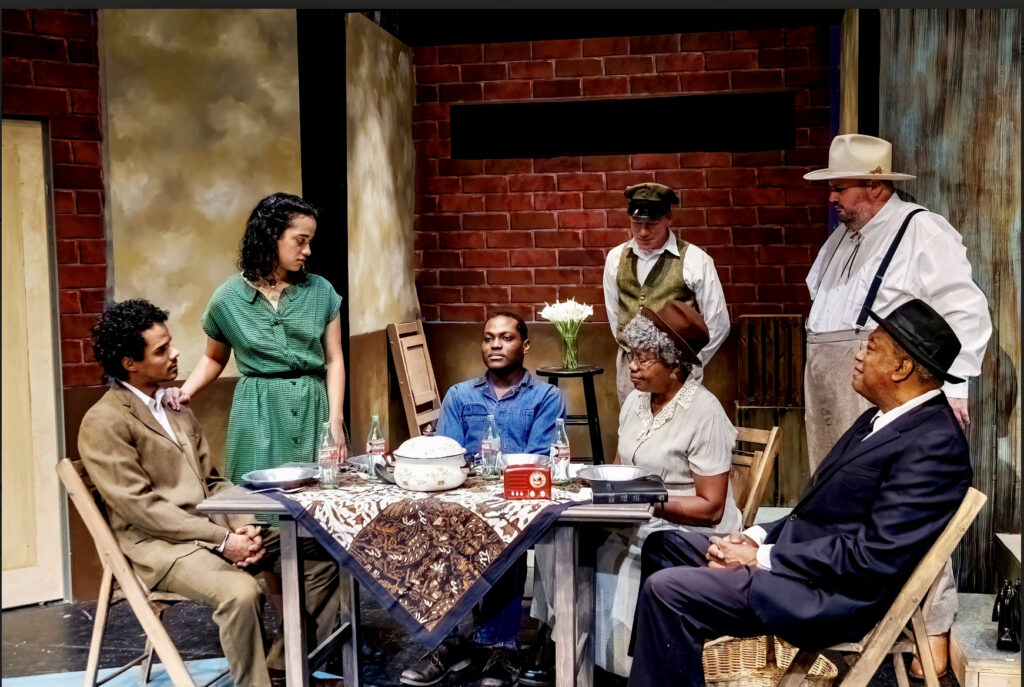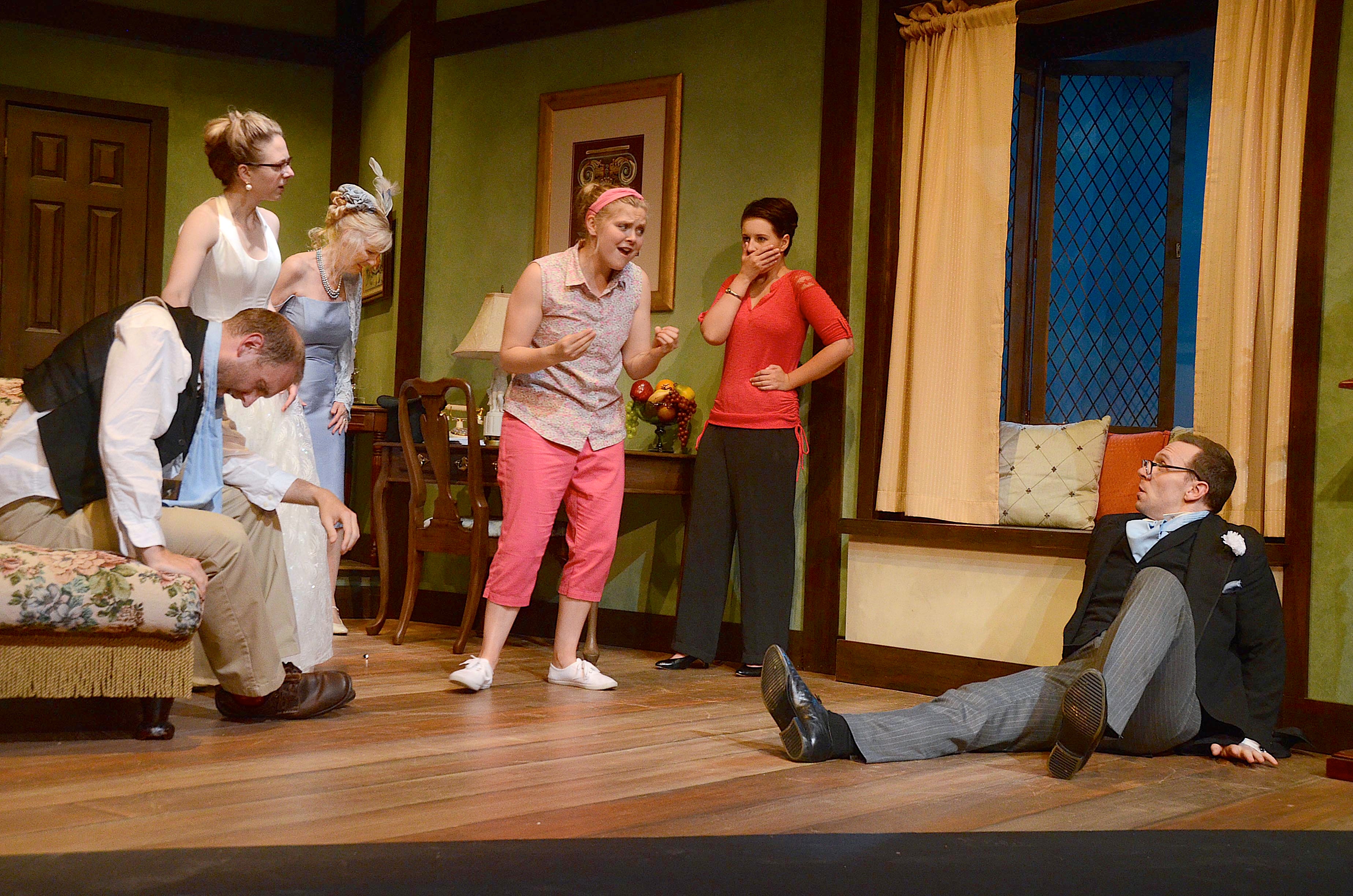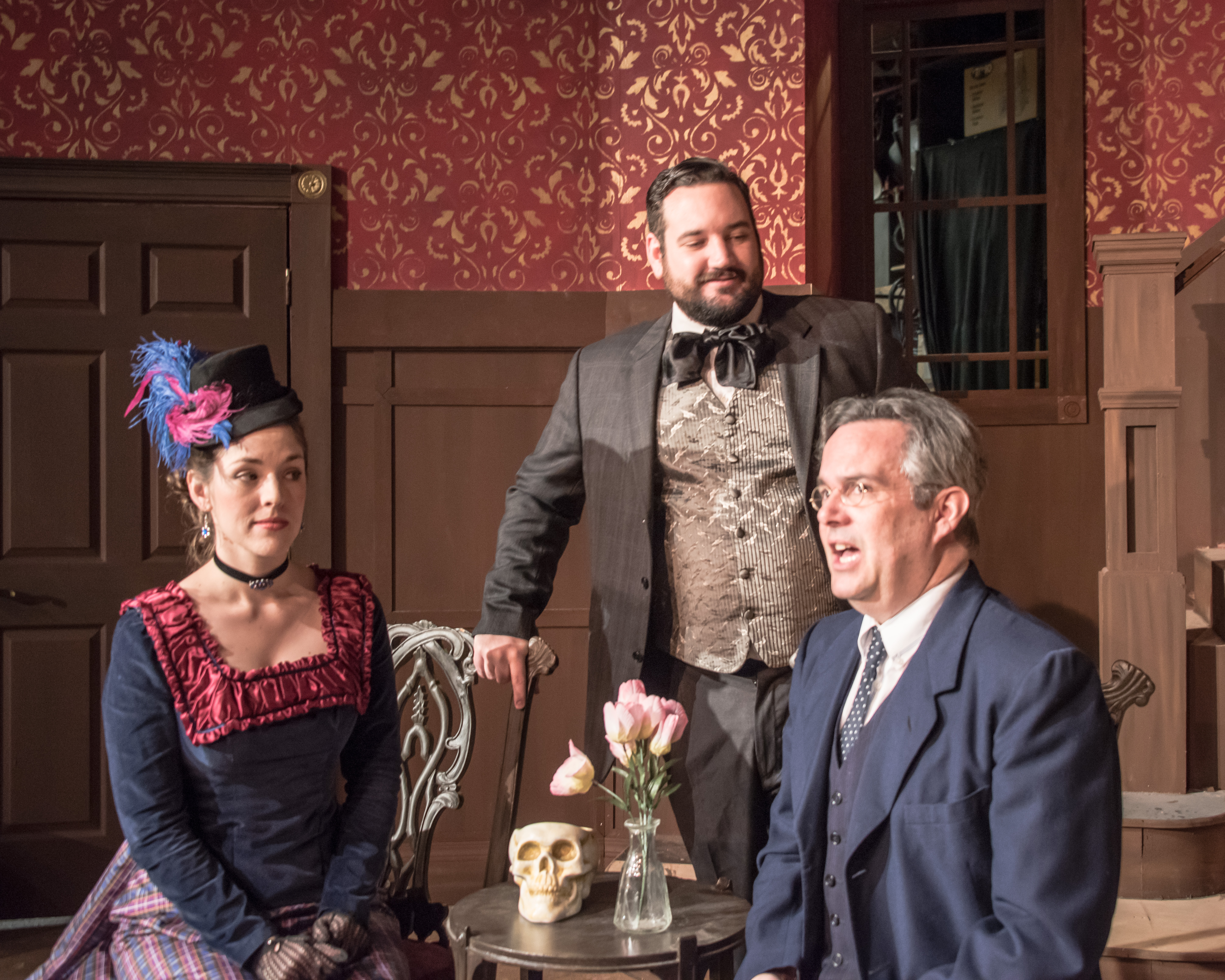By Kelly Oristano
“Why can’t a hero be dragged? Why walk when it’s wrong?” — Jefferson, Act II
My deepest and most abiding concern as an American has always been the national sickness of racial bias in the application of state power, especially the lethal power we entrust to courts and cops. So it was with an anxious but interested heart and mind that I entered A Lesson Before Dying, the latest offering of the Very Little Theatre.
Directed by Hershell Norwood and written by Romulus Linney, based on the 1993 novel by Ernest J. Gaines, A Lesson Before Dying centers on two Black men in 1948 Bayonne, Louisiana. Jefferson, a barely educated descendant of sharecroppers, has been convicted of a murder and sentenced to death, and Grant, a teacher who’s been guilt-tripped into spending some time with Jefferson on death row, aiming to help him take his final walk with dignity.
The trial is done and dusted when we open. No Grisham-esque white knight lawyering is going to exonerate Jefferson here. We’ll eventually learn that he didn’t do it, that every white juror and cop knew he didn’t do it, but that by the rules of 1948 Bayonne, Jefferson’s wrong place, wrong time, wrong skin color trifecta meant he “couldn’t be set free.” The white power structure needed its blood sacrifice and the facts of the case took a back seat.
As Grant reaches his point of maximum crisis with this state of affairs, he complains to Reverend Ambrose, with whom in the past he’s mainly butted heads, “Twelve white men decided Jefferson should die and another white man set the date without consulting any black people!” The Reverend, a generation older than Grant, lacks the capacity to display outrage at this injustice, and saves his concern for Jefferson’s soul, white society be damned.
The core of the play is the delicate dynamic interactions of Grant Wiggins and Jefferson, but there are other characters in Grant’s life who take it in turns to cajole, bribe, and intimidate him into courses of action regarding Jefferson. From one angle, this is Jefferson’s community caring for him, with Jefferson’s godmother Miss Emma, his former teacher Vivian and their Pastor Ambrose all manipulating Grant with benevolent aims. But from another perspective we start to suspect that Grant is the one who’s in the more secure prison, and that maybe the lesson before dying is not solely for Jefferson.
This tension is where the genius of the play lies. Before meeting Jefferson, Grant would likely have deluded himself about the state of affairs in Bayonne. He’d have used all the same truisms and euphemisms and taking-the-long-view homespun wisdom that Emma and The Reverend have had to rely on to explain their lot in life. But as the educated man, the modern intellectual, once Grant has had it all laid out, read the transcripts, seen how brutally railroaded Jefferson has been, the scales fall from his eyes — his honesty becomes beautiful, and his anger becomes righteous and razor keen. It’s deeply satisfying and doesn’t play as manipulative or preachy, but rather as the deserved change of a human being exposed to ugly truths about his fellow humans.
And Jefferson experiences a parallel, but converse, dynamic change. At curtain’s rise, Jefferson has been convinced he’s subhuman by lawyers, judges, juries, and eventually himself. He claims he’ll go to the chair as the hog they all think he is, dragged and dumb. But his exposure to Grant brings about a marvelous, and very real-feeling change in Jefferson which pushes the drama of Act 2 to its brilliant, emotionally and intellectually satisfying conclusion.
VLT serves this material well in all departments. The play could succeed on its very strong script and strong performances alone, but Norwood has considered all elements in his storytelling, and the work of his design team is lovely. The set, designed by Norwood and Tim Tendick, built by Tim Dunn and Amy Dunn, is a vivid and realistic 1940s courthouse store room and Grant’s small rural school room, each of which is set back into the stage at odd akimbo angles which can either increase the claustrophobic feelings or abate them depending on Tendick’s saturated, high-contrast lighting design. The wardrobe is good and the sound design works subtly to deepen the psychological impact of key moments.
Norwood’s direction and Linney’s script are a potent combination. Linney goes through some deep intellectual and emotional explorations to show how these characters cobble together a life. Norwood’s direction is understated, but he moves from picture to picture with a hard focus on the verbal, intellectual, and emotional dredging of each scene for all its value. Here’s a telling passage between Grant and Jefferson that struck me, recreated from memory, so perhaps not perfect:
Jefferson: About God? I just don’t understand.
Grant: That’s good!
Jefferson: Not understanding is good?
Grant: Knowing you don’t is.
And the play is full to the brim of stuff like this, which Norwood has allowed to flourish.
And the cast, good heavens, this cast. All the way down the line, fully committed, fully present characters who were a joy to see, even when they were hard to watch. Adam Leonard and Michael Hoekstra are great as the sheriff and deputy, the only representations of the white power structure to appear. You have to be pretty far down the white power structure to even intersect with this part of society, so we know these two have power in their small domain, but we sense the greater powers that use them to keep their own hands (falsely) clean. Hoekstra shines in some serious, important late moments.
Martha Moultry is delightful as Emma Glenn, Jefferson’s godmother and Grant’s childhood benefactor. Emma has been playing the long game of racial justice since before Grant and Jefferson were born and Moultry captures her effortless wisdom and hard-earned power with humor and grace. Stanley Coleman is full of the spirit and maybe a little bit full of himself as Reverend Ambrose. Much is made of the fact that Ambrose has only read “one book” to Grant’s hundreds or thousands, and Coleman plays that assured pomposity to the hilt, while letting the humanity of the man shine through from underneath.
Zayne Clayton, a newcomer to Eugene and Eugene area stages, is outstanding as Vivian Baptiste, Grant’s girlfriend, also his conscience, and also a complicated human character in her own life story. Her serious, considerate performance helped ground the piece in its time period, and added a necessary point of view.
For the male leads I shall have to empty my superlative satchel. Terrell Dickerson as Jefferson is stunning. His dynamic transition from human hog to human hero is fascinating and rewarding to watch. He shows more and more of Jefferson as the play goes on and by the end is successfully shouldering a ton of responsibility for the impact of the closing moments. His ability to show the light in his eyes when he wants to and to not when he does not is the root of great acting.
Dawaun Lawler as Grant Wiggins gives one of the most fully realized, fully felt, fully believable period character performances I’ve seen on this stage. From the look and the sound to the growing desperation in Grant’s eyes, everything about Lawler’s performance convinces. He has a handful of monologues in the play, delivered as though to his classroom of young rural Black pupils. They are all powerful moments of theatre. The final one is finely wrought and devastating.
It was supremely gratifying to see a cast of local excellent Black actors do a full mainstage production. It shouldn’t be as rare as it is in Eugene and A Lesson Before Dying gets my highest recommendation. I would prescribe it to the whole town if I could.
But in addition to that, I have a vision, or a plea, for the theater-makers in this area: We should see these actors more, and we should not only see them when the material is about unearthing Black Trauma for white audiences. It would be wonderful to see this cast or any portion of it do a Neil Simon play, or a Tyler Perry play, or a Lauren Gunderson play. See this show, seek these actors out, and invite them into other theatre making spaces.
If we don’t, how much have we improved upon Bayonne in 1948?

A Lesson Before Dying at The Very Little Theatre









